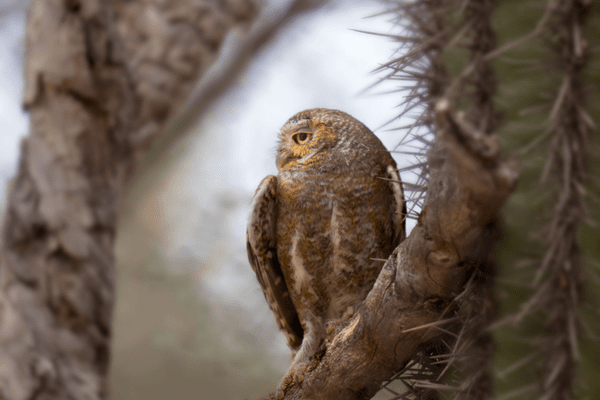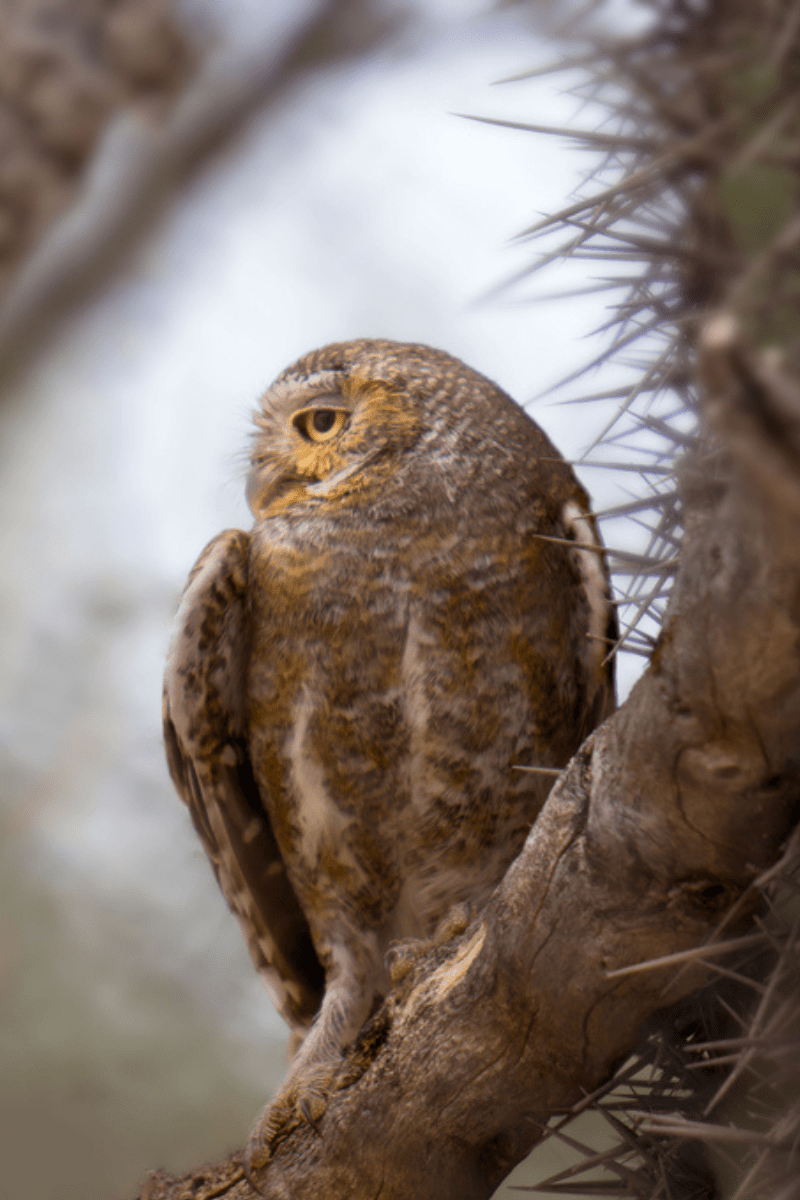Contents
- Elf owl facts
- Elf owl: how-to identify
- Where You’ll See An Elf owl
- Elf owl diet
- Elf owl nesting
- Elf owl behavior
- How-to attract elf owls
- Elf owl threats
- Elf owl fun & interesting facts
- Elf owl FAQ
- How big is a baby Elf owl?
- What does the Elf owl look like?
- How does an Elf owl adapt to its habitat?
- Is the Elf owl rare?
- Are Elf owls friendly?
- How long does an Elf owl live?
- Why do Elf owls live in cacti?
- Where does the Elf owl live?
- What does an Elf owl eat?
- What does an Elf owl sound like?
- What animals hunt Elf owls?
- How fast can an Elf owl fly?
- How does the Elf owl get its food?
- Elf owl related species in this family
The elf owl is a member of the owl family Strigidae with many different nicknames. It’s also known as Sanford’s elf owl, Texas elf owl, and Whitney’s elf owl.
In North America, two of the four recognized elf owl species are located and live here. The Texas elf owl resides in southern Texas, which shouldn’t come as a shock to anyone based on its name. You’ll find it along the southern tip of Texas all the way into central Mexico.
The Whitney’s elf owl is known to breed throughout the Southwest United States, but it also migrates for the winter into the south in Mexico.
Besides these critical facts, I’ll tell you other information about this interesting owl and share it with you today. The topics I’ll cover include:
- Identifying qualities of the elf owl
- Fun and interesting elf owl facts
- Elf owl characteristic differences between females and males
- Migratory habits, feeding habits, dietary preferences, nesting behaviors
- Additional elf owl facts and information
To learn more interesting facts and information about elf owls, please continue reading.
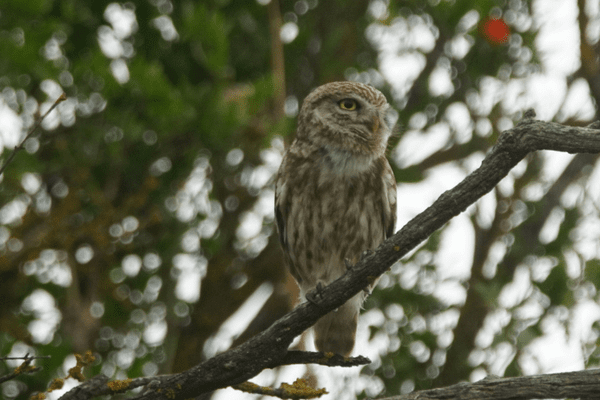
Elf owl facts
- Common Name: Elf Owl
- Scientific Name: Micrathene whitneyi
- Scientific Family: Strigidae
- Life Span: 3-6 years
- Size: 5.0 to 5.75 inches
- Wingspan: 13.5 to 16.5 inches
- Weight: 1.0 to 1.5 oz
- Conservation status: Least Concern
Elf owl: how-to identify
one way to identify an elf owl is by their lack of ear tufts. They do not have any pointy feathers sticking out of the top of their round heads. They have grayish brown feathers, and pale yellow eyes, and their eyes have thin white eyebrows highlighting them. Their bill has a horn-colored tip and it’s mostly gray.
Differences Between Male & Female
There is really only one major difference between male and female elf owls. Their look is practically identical. But they definitely differ in size. On average, a female elf owl is typically 3%-6% heavier than her male counterpart. She also has a larger wingspan.
Differences In Summer Plumage vs Winter Plumage
The color of elf owl plumage remains the same whether it’s summer, winter, spring, or fall. It does not change with the seasons.
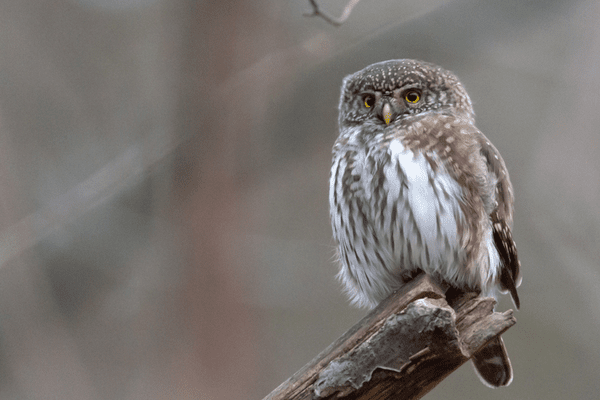
Where You’ll See An Elf owl
Elf owls have a presence in the United States of America as well as central Mexico. In the US, these owls like to spend their time in desert cactus habitats and woodlands in the southwestern part of Texas. They also make their home in southern Arizona and New Mexico as well, because they like the hot desert climate. Besides these places, you can also find them in Central Mexico and Baja California.
Elf owl bird migration
These owls will migrate to the southwestern part of the United States of America in New Mexico, Texas, Arizona, and California. They specifically Margarita these areas in the spring and summer months for breeding purposes. In the winter, they will actually leave the area and spend the colder winter months in central and southern Mexico, but they begin heading up north once again in mid-April or early May.
Elf owl diet
The elf owl is very similar to other owls because it is a nocturnal predator. The diet of the elf owl is mostly made up of insects including grasshoppers and scorpions. They are also carnivores and they will eat small lizards, mice, and other mammals or small creatures. They are even known for eating crickets, moths, and beetles in the desert regions of Arizona.
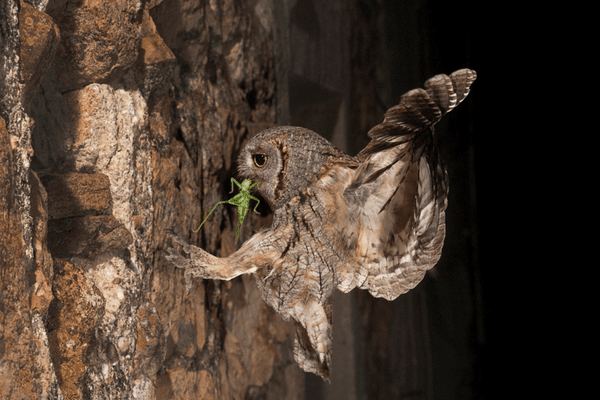
Elf owl nesting
- Clutch Size: 1-5 eggs
- # of Broods: 1 brood
- Incubation Period: 24 days
- Nestling period: 28-33 days
- Egg Description: White
Elf owls prefer to nest or abandoned woodpecker holes and natural tree cavities found in sycamores, Oak trees, and giant cacti. More often than not, these nests are anywhere from 15-35 feet off the ground.
Elf owls will even tolerate nesting boxes in neighborhoods that are filled with plenty of trees. So, if you’re looking to attract an elf owl, you may choose to put up a nesting box in your backyard.
Elf owl behavior
- When this owl is captured, this tiny little bird will actually play dead. It will act like it is dead until it is no longer in danger.
- This creature is not a very aggressive bird. In fact, instead of getting into a fight, the bird will take a nonaggressive action and actually fly away from the potential danger. This is likely because it’s one of the smallest owls in the world.
- This owl mainly consists of nocturnal insects, which are very difficult to find in desert regions because it gets too cold at certain times of the year. That’s why this owl tends to migrate during the winter months and it will spend time in the southern part of Mexico where it is much warmer.
- As a nocturnal creature, the majority of the activity that this owl enters into will take place prior to dawn or immediately at dusk.
- When this tiny owl moves, it does so by hopping and walking. It also has the ability to climb, which is very similar to a parrot. But it doesn’t spend too much time flying.
- During the hunt, this creature will strike its prey in a straight line. When flying between perches, they do so in a U-shaped arc, but they actually prefer to harbor and glide during flight.
- Not every population of this owl is migratory. There are sedentary populations that remain in the same place, which is typically a warmer climate like Mexico.
How-to attract elf owls
It’s definitely possible to attract this creature to your backyard. Some tips to consider include the following options:
- Place a nesting box in your backyard. This is going to be very effective if you happen to live in a place with lots of trees or a densely wooded area. They like to live in tree cavities, but they will also move into a nesting box when it’s available.
- Avoid mowing your lawn as often as you possibly can. This makes it possible for small insects, rodents, reptiles, and other tiny mammals to have places to hide in your backyard. They need this prey readily available to have something to feed on.
- Consider adding a birdbath to your backyard. Leaving an available water source on hand for them makes it easy for them to have a place to bathe and a proper place on hand to bathe and clean their young ones and mate.
- Do not trim your tree branches unless it’s absolutely necessary. Leaving tree branches available for elf owls to perch on will certainly attract them to your backyard.
Elf owl threats
The conservation status of this owl is considered Least Concern. What does this mean? It means this minuscule owl isn’t in immediate danger of becoming extinct.
Although the habitats for them have declined throughout the year due to agricultural and home development. So, in certain places like California, because of deforestation, these owls are actually considered endangered. But overall throughout the other parts of the southern United States and Mexico, there are still enough elf owls in existence that it hasn’t officially been declared an endangered species at this time.
Elf owl fun & interesting facts
- Out of every owl in existence today, they are considered the smallest in the world.
- Out of every owl in existence today, the elf owl is considered the lightest in the world.
- When the elf owl is captured or handled by human beings, it will actually play dead and remain in this state until the human being or predator relaxes its grip and gives the elf owl the opportunity to escape.
- If the elf owl were ever to be disturbed, it would produce a noise that sounded like “chee-ur.” This is a loud and relatively annoying screech-like sound that will potentially scare away the disturbance. They also tend to clap their bills together when they are disturbed.
- Believe it or not, elf owls do not have to drink water in order to remain hydrated. Their diet actually provides them with ample amounts of water to keep this small and minuscule creature properly hydrated.
- Elf owls are known for recycling woodpecker holes. In fact, moving into old woodpecker holes is their favorite nesting spot. They typically find these woodpecker holes in oak trees, sycamore trees, mesquite shrubs, or Saguaro cacti. They’ll usually pick a nesting box or a hole in a telephone pole if a woodpecker hole isn’t available.
Elf owl FAQ
How big is a baby Elf owl?
The baby elf owl is incredibly tiny. While it’s difficult to pinpoint the actual size, it’s only going to be a couple of inches in height and it will weigh less than an ounce. The elf owl is the smallest owl currently in existence right now.
What does the Elf owl look like?
The elf owl is very distinctive and it has unique features. It’s grayish brown in color covering all of its feathers. It has pale yellow eyes and eyebrows that are thin white lines. It has a great bill and the tip of the bill is horn colored.
It’s also the smallest owl in existence today. Adults are only 5-6 inches in height and it typically weighs only 1.4 ounces.
How does an Elf owl adapt to its habitat?
The biggest way that the elf owl adapts to its habitat is its coloration. The elf owl has a dusty brown color and its feathers have waited for spots. This helps it blend into the background and axes camouflage. You can easily hide within a tree trunk Hollow without being noticed by other owls or other predators. It also has keen night vision and an excellent sense of hearing, which allows it to remain safe from harm.
Is the Elf owl rare?
The elf owl is part of an owl species that are decreasing in number. It’s very rare to find one of these owls in Texas and California at this point because their numbers are severely dwindling. In Arizona, on the other hand, it isn’t uncommon to spot an elf owl in the wild. They are still existing in plentiful supply in the state of Arizona.
Are Elf owls friendly?
No, unfortunately for human beings, the elf owl doesn’t like their company. It is known as a solitary bird and it likes to keep to itself and its own kind. It isn’t a friendly creature toward human beings, which is unfortunate because it’s such a cute little bird.
How long does an Elf owl live?
Elf owls do not have the largest lifespan when compared to other owl species, but they could potentially live long and healthy life. There are lifespan differences between those that live in the wild as opposed to those living in captivity under human care.
For example, the estimated lifespan of elf owls living in the wild is 3-6 years. On the other hand, the estimated lifespan of these owls living in captivity rises quite a bit. They are expected to live anywhere from 6-10 years or more when being cared for in captivity.
Why do Elf owls live in cacti?
In truth, the biggest reason why elf owls live in a cactus is that they predominantly live in desert regions. In Arizona, for example, desert cacti are in plentiful supply. That’s why elf owls depend on and rely on these cacti for their home and shelter. They also live in wooded canyons in trees which they use for nesting.
Also, Flickers and Gila Woodpeckers live inside holes within desert cacti. They rely on these insects for food, so it’s important to remain close to their food source.
Where does the Elf owl live?
The elf owl lives in North America in California, Texas, and Arizona. Although as of late, the population of this owl is dwindling and practically nonexistent in Texas and California.
They are still available in plentiful numbers in the dry regions of Arizona. These diminutive owls like to live in deserts, riparian woodlands, dry thorn forests, and pine-oak forests. You can easily find them on the southern border of the US and in parts of Mexico.
What does an Elf owl eat?
Elf owls are very similar to other owls because they are nocturnal predators. Their diets are primarily made up of eating insects including grasshoppers and scorpions as well as flickers and Gila woodpeckers.
Those aren’t the only sources of food in their diet. They will also eat small lizards and mice as well when the opportunity arises. But they particularly prefer eating insects and other answer pods including crickets, beetles, katydids, and moths.
What does an Elf owl sound like?
The elf owl is known for making calls and singing songs.
The male elf owl sings songs at night that consist of a series of 5-7 yapping nasally notes with a descending pitch at the end. Some people consider this song similar to the sounds made by a barking puppy.
Most commonly, the elf owl can be heard making a call known as the station call. This call consists of a slurred, soft whistle that they make during nesting season. They also make a high, barking, sharp sound that sounds like a “cheer” as an alarm when danger arises and they need to warn other owls in the vicinity.
What animals hunt Elf owls?
Although the elf owl is a nocturnal predator, it is also the prey of other larger, scarier, and bigger predators. The predators of the elf owl include larger owls, ringtails, coyotes, snakes, and bobcats. All of these deadly creatures can be found in the Arizona desert, which is predominantly the area in which they make their home.
How fast can an Elf owl fly?
Nobody knows for sure just how fast an elf owl can fly. Scientists believe an estimate that it can fly anywhere from 7-20 km/h. This equals anywhere from 4 ½ to 12 mph, which is pretty fast if you ask me. Others believe that the elf owl can fly as fast as 40 mph, but I have no way of confirming whether this is true or not.
How does the Elf owl get its food?
The elf owl gets its food by hunting at night. It has a small territory in which it will hunt for small prey. It emits puppy-like calls to mark its territory. It also nests inside old woodpecker hole cavities, which it will emerge from to hunt various insects including beetles, centipedes, crickets, scorpions, spiders, and moths.
These nocturnal foragers are also capable of catching their prey in flight, within the trees, and on the ground.
- Long-Eared Owl
- Spotted Owl
- Burrowing Owl
- Flammulated Owl
- Boreal Owl
- Northern Pygmy-Owl
- Western Screech-Owl
- Barred Owl
- Northern Hawk Owl
- Short-Eared Owl
- Northern Saw-Whet Owl
- Snowy Owl
- Great Grey Owl
- Eastern Screech-Owl

